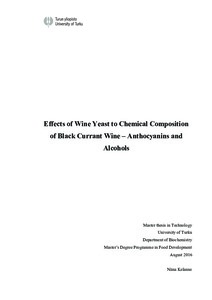Effects of Wine Yeast to Chemical Composition of Black Currant Wine - Anthocyanins and Alcohols
Kelanne Niina
https://urn.fi/URN:NBN:fi-fe2021042720111
Tiivistelmä
Wine has been made over 7000 years. Usually wine is made from fruits of Vitis vinifera,
but other raw material can be used and then wine is called fruit wine. Grape vines do
not grow well in Finland. That is why the most of the wines produced in Finland are
produced from other raw materials than grapes. Even 200 000 liters of fruit wines are
produced yearly. The most used wine yeasts species are different Saccharomyces
cerevisiae varieties, because they can use many different sugars as a source of energy
and they tolerate the high concentrations of ethanol. Use of non-Saccharomyces species
have increased, because they have positive effects on sensory properties of the wine.
The yeast species effects on fermentation time, concentrations of ethanol and other
alcohols, stability of anthocyanins and sensory properties. It is important to know
differences between yeast species to get best result in fermentation and aromatic
compounds.
In this study 11 wines were made by using two black currant varieties, Mikael (LUKE’s
variety 17) and LUKE’s variety 15, and four commercially available yeast products,
two Saccharomyces cerevisiae, one S. bayanus and one Torulaspora delbrueckii
species. The wines were made by applying commercially available home wine methods.
Fermentation was monitored with pH, °Brix and specific gravity assays. Alcohols were
analyzed with GC-FID instrument and anthocyanins were analyzed and identified first
with HPLC-DAD instrument and final identification was made with UHPLC-DAD-MS
instrument.
Yeasts were noticed to have different lag phases and fermentation time. Ethanol and
three other alcohols, methanol, isoamylalcohol and isobutanol, were identified from
wines. The concentration of ethanol was the highest in the S. cerevisiae wines and
lowest in the S. bayanus wines. The amount of the higher alcohols were the highest in
wines fermented with T. delbrueckii. Four main anthocyanins, characteristic in black
currant, and six other anthocyanins were identified from the wines. Two of
anthocyanins were acylated anthocyanins. The yeasts had significant effect on final
anthocyanin concentration than black currant species. The final concentrations of the
Kokoelmat
- Rinnakkaistallenteet [19250]
